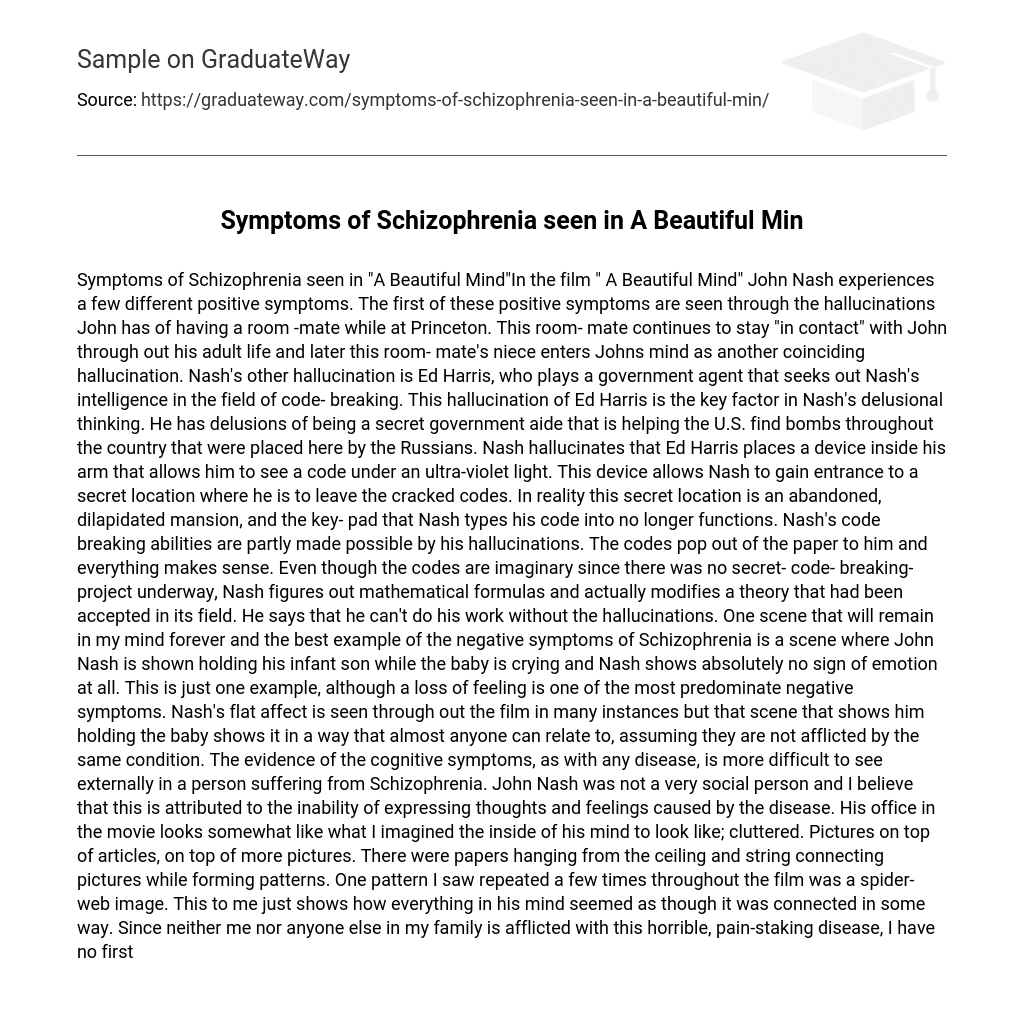In the movie “A Beautiful Mind”, John Nash experiences various positive symptoms. Initially, he hallucinates having a roommate while studying at Princeton. Throughout his life, this imaginary roommate continues to communicate with him, and later on, the niece of this hallucination also becomes part of his experiences. Another hallucination Nash encounters is depicted by Ed Harris, who plays a government agent that acknowledges Nash’s brilliance in code-breaking.
The hallucination of Ed Harris plays a crucial role in Nash’s delusional thinking. He envisions himself as a secret government aide working to uncover bombs planted by the Russians across the country. Nash imagines that Ed Harris implants a device in his arm, enabling him to see a code under ultraviolet light. This device grants Nash access to a hidden location where he is supposed to deliver deciphered codes. However, the truth is that this secret spot is actually an abandoned, rundown mansion, and the keypad Nash uses to enter his code no longer functions. Nash’s ability to break codes is partially facilitated by his hallucinations.
The codes appear to Nash from the paper and he comprehends everything. Despite the fact that the codes are not real as there was no ongoing secret code-breaking project, Nash deduces mathematical equations and even alters an accepted theory in his field. He claims that he is unable to perform his work without these hallucinations. There is one particular scene that will never leave my memory and serves as a prime illustration of the adverse symptoms of Schizophrenia: Nash is depicted holding his crying infant son, yet displaying no emotion whatsoever.
This is only one instance, and though there are many instances showing Nash’s flat affect in the film, the one scene where he holds the baby is particularly relatable to anyone who does not have the same condition.
When it comes to Schizophrenia, the cognitive symptoms may not be easily noticeable in a person. John Nash’s lack of social interaction can be attributed to the disease’s impact on expressing thoughts and feelings. In the movie, his office reflects his mental state with a cluttered arrangement of pictures, articles, hanging papers, and interconnected strings forming patterns.
Upon observing the film, I consistently noticed a recurring spider-web image that, in my interpretation, represents the interconnectedness of everything within the protagonist’s mind. Due to the absence of personal experience with this distressing illness from both my family and myself, I am lacking firsthand knowledge on this subject.
To gain a comprehensive understanding of this disease, one needs to be extensively engaged in it and directly observe its impact on both the affected individual and their loved ones. John Nash, despite being diagnosed with Schizophrenia at a later stage in life, experienced significant effects from his symptoms. He openly admitted that he did not derive pleasure from social interactions and held the belief that others avoided his company. While he maintained relationships with colleagues based on academia, he was oblivious to the fact that these colleagues considered themselves as his friends.
Due to his intelligence, he was highly respected and his social awkwardness was seen as a unique aspect of his brilliance. Only his wife truly understood him and supported him during his illness. However, John struggled to form a strong emotional bond with her because he couldn’t express emotions or experience joy. This must have been extremely challenging for her, especially since she had no awareness of his illness.
Upon learning that the man had been diagnosed with Schizophrenia, his wife grew fearful and hesitant about leaving him alone with their child. It seems unfathomable that one cannot trust their own spouse to safely care for their child without worrying about potential harm. Prior to taking this class or watching the film, I had never witnessed someone going through a psychotic episode caused by Schizophrenia, which left me completely unaware of how to respond appropriately. However, I now comprehend that there is limited action one can take besides assuring the individual of their loved status and being present as a supportive listener.
I acknowledge that coping with a disease can be exasperating for both the person affected and their close ones. The inability to grasp one’s own thoughts and differentiate between reality and delusions must be extremely distressing. It becomes particularly difficult to persuade someone of their condition when they are incapable of acknowledging it themselves. Should an individual find comfort in their delusions, they may question the significance of uncovering the truth.





